Blog Page & News Articles
Dental Occlusion: What is means and how it affects your natural bite
Author: Dr Behnam Aminnejad. Posted: 29.01.24
Dental occlusion, commonly known as the way your teeth meet when your jaws come together, is pivotal for oral health. When teeth do not align correctly, it can lead to issues in the teeth, gums, temporomandibular joint (TMJ), or the muscles responsible for jaw movement.
There are many variations, typically classed as:
Overbite: occurs when the upper front teeth overlap the lower front teeth vertically. In other words, the upper front teeth
protrude over the lower front teeth when the mouth is closed.
Underbite: The opposite; when the lower teeth are more prominent compared to your upper teeth
Crossbite: One or more of the upper teeth biting on the inside of the lower teeth
Open Bite: Inadequate vertical overlap of the front teeth characterizes an open bite
Overjet: When your upper teeth sit over your lower teeth
Crowding: Occurs with large teeth and/or a relatively small jaw causing teeth to be pushed into an abnormal position, forward,
backward or overlapping.
Many individuals adapt to imperfect occlusion and missing teeth without noticeable symptoms. However, heightened stress and tension, ageing, can occasionally bring forth symptoms, ranging from flattened and worn teeth to broken dental work and persistent sensitivity to temperature changes. If you suspect any of these issues, consulting with your dentist is crucial.
Some people unconsciously clench or grind their teeth, often associated with stress or concentration on specific tasks. This behaviour, known as bruxism, can result in a stiff jaw, morning tenderness, and other related symptoms. Interestingly, most teeth grinding occurs during sleep, making individuals unaware of the habit.
Severe headaches, neck and shoulder pain, or discomfort around the ears and jaw joints might be indicators of temporomandibular joint (TMJ) problems. Additionally, missing teeth at the back of the mouth can create an unbalanced bite, causing uneven pressure on the teeth.
Collectively, these symptoms are termed 'TMJ syndrome'. Treatment options vary, including relaxation techniques, dietary adjustments, exercise, dental guards to prevent nighttime clenching, and the replacement of missing teeth to provide more balanced jaw support. Orthodontic appliances or braces may also be recommended to improve tooth positioning.
In Summary
Issues with under or overbites tend to become more noticeable with age, often exacerbated by hormonal changes, menopause, or tooth loss. Seeking advice from your dentist is essential to explore available options and receive appropriate guidance. Keep in mind that certain treatments, such as braces or dental guards, will take time to show improvement, emphasising the importance of initiating treatment as early as possible.
Read more of Dr Behnam Aminnejad's dental care articles and tips: Back to Blog

Why Choose Us?
- Master's degree in Endodontic (Root canal treatment)
- Almost 30 years experience
- All dental treatments are individually tailored to your specific needs
